Accelerating Saudi Arabia’s economy by using Intelligent Automation

The year 2016 was a momentous one for Saudi Arabi as it embarked on a massive transformation journey on the back of Vision 2030 initiative with a core focus to diversify the economy and enhance the socio-economic outlook of the country. Investments in high growth sectors, renewed focus on developing private sector, strengthening technical infrastructure and undergoing a massive digitisation journey by fueling digital skill programs have been identified as key enablers to help make this vision a reality.
Saudi Arabia is at a critical juncture in its transformation journey. Since the launch of the Saudi Vision 2030 plan in 2016, the government has initiated crucial economic measures and bold social reforms to diversify its economy with a specific emphasis on technology. The impact of Covid-19 on the world economy has been severe with the World Bank terming it the worst recession since World War II.
The Saudi Arabian economy is no exception and is expected to decline by 6.9%, Nominal GDP, with the impact exacerbated by plummeting global demand for crude oil. Covid-19 created a setback to Saudi Arabia’s economy similar to other nations globally. Saudi Arabia currently needs to quickly recover and get back on its path of accelerated transformation.
This is hence an opportune time to explore how the country can tap into the economic benefits resulting from technology induced increase in productivity to make up for the deficit. To leverage technology led productivity enhancement and to realise the economic benefits within the timeframe, Saudi Arabia needs to accelerate its transformation journey, through a digital-first mindset realised through investments in new-age digital technologies such as Artificial Intelligence, automation, Internet of Things, cloud.
Focus on non-oil
Saudi Arabia has laid strong foundations by setting a strategic direction with its Vision 2030 plan and actively promoting private and public partnerships to drive the adoption of Intelligent Automation in the country. To further accelerate the Intelligent Automation journey, the country needs to focus on three critical enablers.
First, accelerating the digital journeys of government entities and private enterprises by assisting them in adopting end-to-end digitised systems that can deliver fast and secure services through the cloud. Second, transforming the local talent by focusing on training and development in digital skills to make them future ready. Third, building a strong ecosystem of start-ups, enterprises, government, and academia to drive innovation and speed up the transformation process.
Saudi Arabia experienced a ~4x growth in their economy between 2000 to 2014, coinciding with the boom in oil prices. This growth catapulted Saudi Arabia’s economy from being the 27th largest in the world in 2003 to becoming the 19th largest in 2014. However, the country continued to remain oil-reliant despite development plans to diversify the economy dating back to as early as 1970. In late 2014 and 2015, owing to the steep decline in oil prices, Saudi Arabia experienced a major setback to their economy that drastically slowed down their growth rate.
The diversification efforts started showing results in 2019 when Saudi Arabia witnessed strong performance of the non-oil sectors with the overall GDP growing at 0.8% despite the oil sector contraction of around 3.65%. The seeds of this resilience in the economy were sown in 2016 with the launch of Saudi Arabia’s ambitious socio-economic program titled Vision 2030 under the leadership of King Salman bin Abdulaziz Al Saud and Crown Prince Mohammed bin Salman Al Saud.
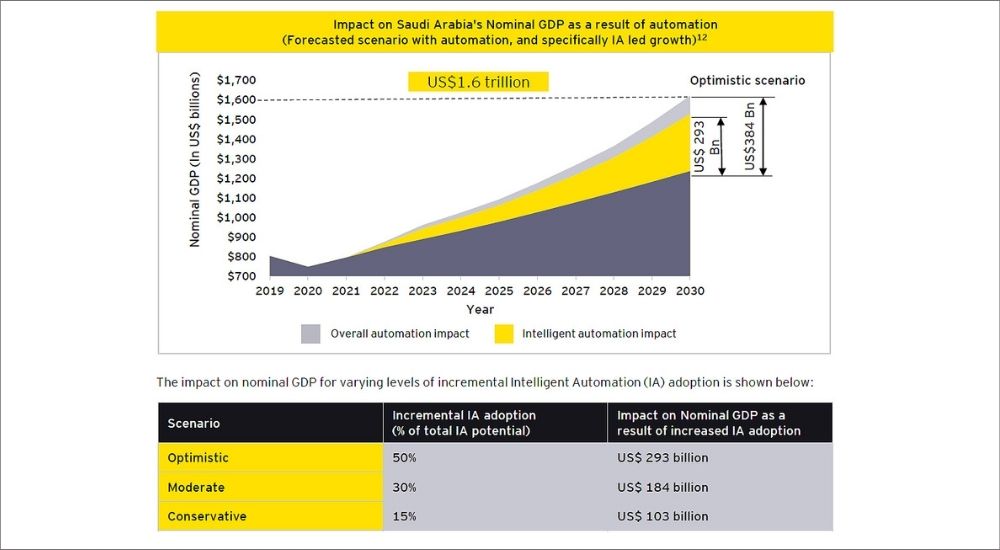
Saudi Arabia has based Vision 2030 goals on three pillars of competitive advantage, as the heart of Arab and Islamic world, the country’s investment prowess, and strategic location for international trade connecting Africa, Asia and Europe. While these pillars provide a unique advantage to Saudi Arabia, three additional factors will be pivotal for the kingdom in their journey to transform the nation.
- Visionary leadership and reform
- Accelerating technology across sectors
- Education and vibrant workforce
Saudi Arabia’s visionary leadership and their continued focus on reform manifested in 2030 goals has helped the kingdom add $150 billion to its GDP, since the launch of the plan in 2016. As per global think tanks and research agencies, the country has the potential to double its GDP by 2030 while simultaneously reducing its dependency on oil and gas sector.
To drive sustained long-term growth, it is critical to factor in technology-led productivity improvement that would help compound the economic output generated from assets, resources and human capital – that are invariably finite. Multiple studies have proven that countries that have embraced new-age technologies and invested in building skills of the future, have witnessed positive economic growth on the back of improved labor productivity.
Labor productivity has a direct co-relation with the digital capabilities of the country. World’s leading economies such as the US, Germany have improved labor productivity through significant investments in technology and building digital skills amongst their workforce. This has helped drive consistent economy growth.
Digital transformation has hence been recognised as a key enabler for achieving Vision 2030 goals and the kingdom has made significant investments to propel technology adoption across key sectors. The country’s 14 million strong workforce when equipped with skills covering new technologies, digitised processes and efficient ways of working will invariably increase the labor productivity thereby accelerating economic growth.
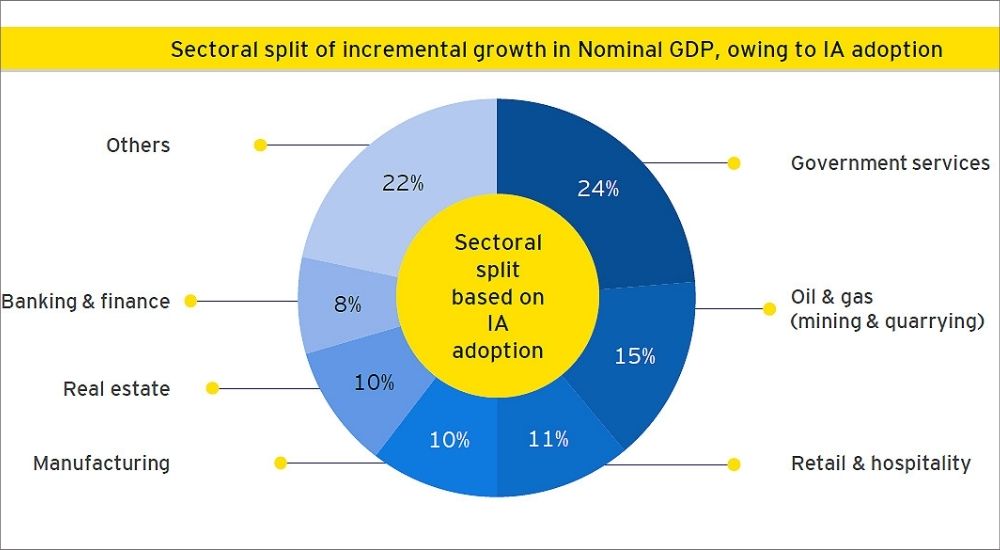
Digital transformation
While some automation technologies have been around for a few years, Intelligent Automation is causing a disruptive revolution for organisations and entities that is dramatically changing the way they operate. Automation solutions handle routine, repetitive work thereby increasing the productivity of the workforce.
However, as traditional levers of productivity improvement mature, Intelligent Automation is emerging as a key lever in driving forward the transformation across sectors. Higher investments in automation across sectors has a direct impact on improving the productivity. Improvement in productivity, leads to an increase in economic output.
Intelligent Automation is a continuum of technologies which builds upon the existing automation architecture and combines Cognitive solutions and RPA to deliver rapid end-to-end process automation at scale. It makes operations smarter and autonomous by leveraging technologies such as Machine Learning, Natural Language Processing and Natural Language Generation.
Intelligent Automation– a combination of AI and Robotic Process Automation has the potential to act as a key lever in realising the technology led productivity enhancement. Intelligent Automation is unquestionably amongst the top digital transformation enablers for enterprises and government with compelling and proven benefit of productivity gains.
Intelligent Automation has all the key characteristics of being an active catalyst in accelerating Saudi Arabia’s digital transformation journey and assisting Saudi Arabia to realise its vision. Emphasis on increased adoption of Intelligent Automation as a fundamental element of digitisation is one of the common traits observed across the most digitally advanced countries in the world.
Improving the digital and cloud adoption, aiding the transformation of the skillset of its citizens and creation of an ecosystem that fosters innovation form the key enablers that Saudi Arabia needs to target. Accelerated Intelligent Automation adoption would enable the enterprises to compete globally and the government entities to drastically improve the quality of governance and citizen services – both of which form the core for Saudi Arabia to become a global powerhouse.
The true potential of Intelligent Automation can only be realised by accelerating the digital and cloud adoption in both government as well as private enterprises in the country. Digital and cloud infrastructure will enable them to deliver services through digital channels in short time and at scale.
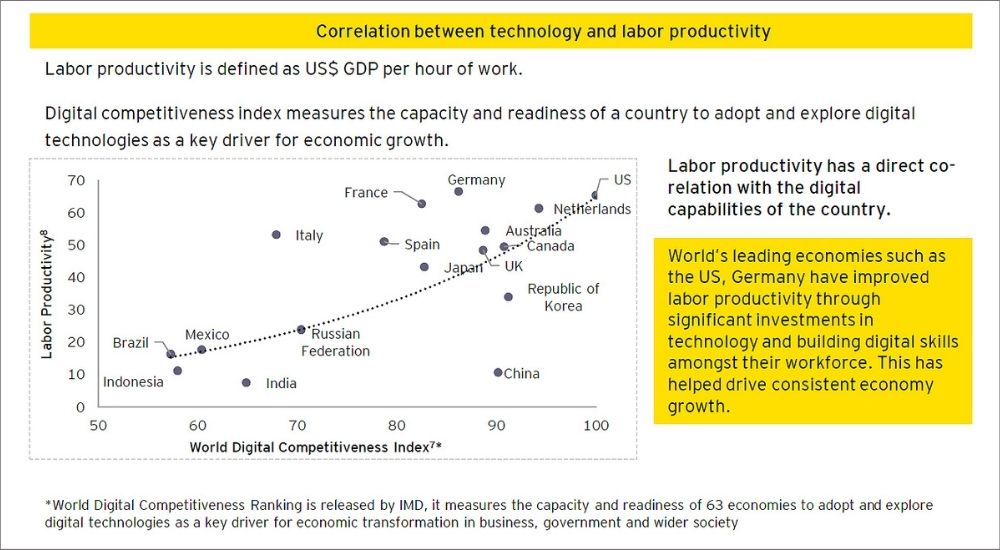
Intelligent Automation and GDP
Intelligent Automation can act as a potential game changer for Saudi Arabia in its quest to attain the goals highlighted as part of Vision 2030. Even in a moderate growth scenario, a 30% incremental realisation in the automation potential over and above the current automation level, can boost Saudi Arabia’s economy by adding $293 billion to its nominal GDP by 2030.
In addition to the potential incremental GDP growth, Intelligent Automation would act as a stimulus for the growth of non-oil sectors. Sectors such as government services, banking and insurance and energy and materials are poised to be the biggest beneficiaries of increased Intelligent Automation adoption.
The productivity improvement for a sector that can be achieved through automation technologies varies on the basis of current adoption of automation and the future automation potential of the sector. To quantify the potential impact of automation technologies on Saudi Arabia’s economy by 2030 and calculate the productivity improvement across sectors, a realisation percentage of the automation potential across each sector was estimated.
A key hypothesis considered is that Intelligent Automation will act as a virtual workforce performing the identified activities and the freed up human resources will re-join the workforce with enhanced skills and higher productivity than before.
- A ~30% incremental realisation in the automation potential over and above the current automation level, can boost Saudi Arabia’s economy by adding $293 billion to its total GDP by 2030.
- A ~15% incremental realisation in the automation potential over and above the current automation levels, can add $103 billion to Saudi Arabia’s GDP by 2030.
Government services and public sector, banking and insurance and energy and materials emerged as top sectors that would contribute the most to the incremental growth in GDP due to Intelligent Automation and also happen to be the key focus sectors of the country’s diversification plan.
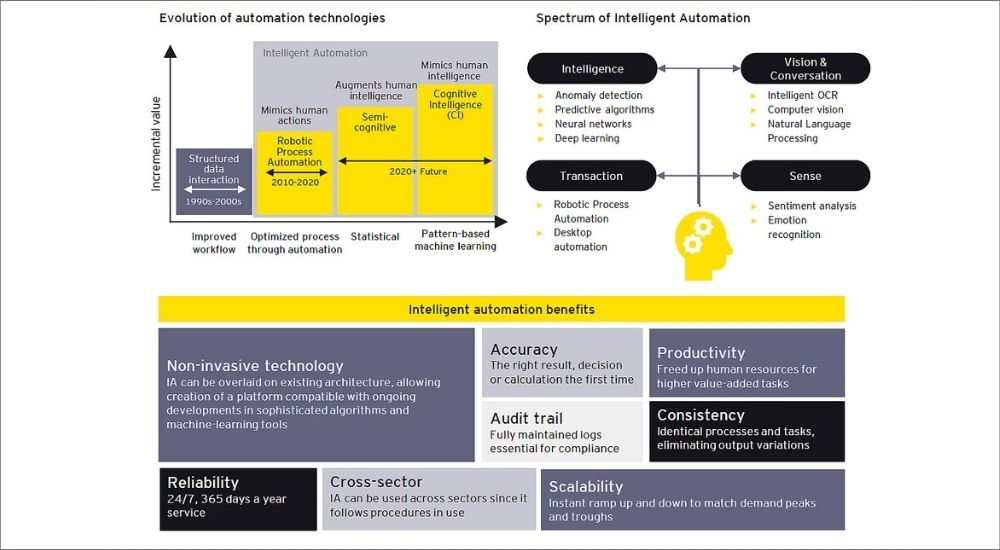
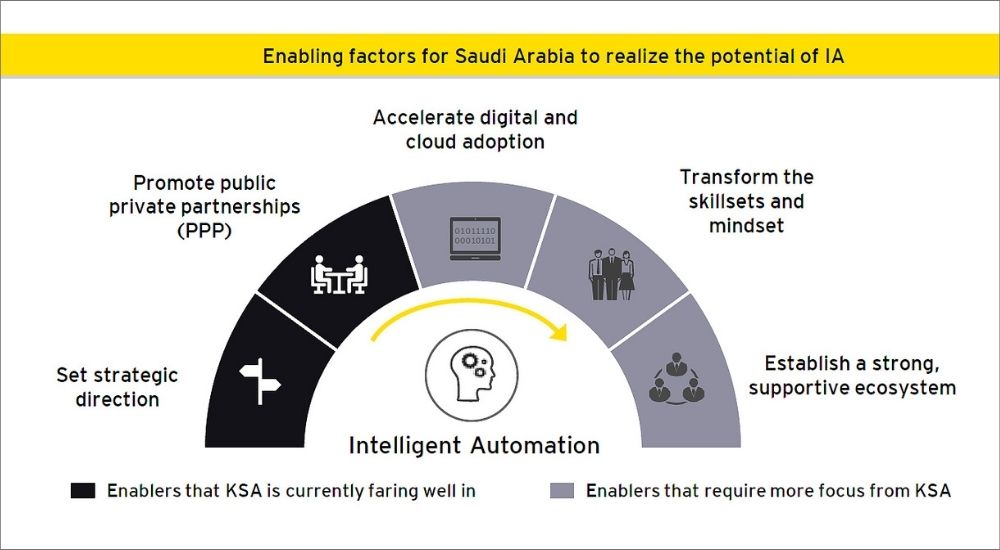
Building the digital nation
Some of the major building blocks of digital and cloud adoption include:
Technology infrastructure
In an effort to boost the non-oil sectors, Saudi Arabia has focused on investing in the digital infrastructure in the country. As part of the smart cities and giga-projects, the government has been investing in the infrastructure connectivity through the deployment of fiber-optic, wireless networks and mobile broadband.
As of 2019, Saudi Arabia has the 13th fastest internet speed in the world and has the third largest 5G network in the world. The existing digital infrastructure acted as a key foundation to speed up citizens’ adoption of digitised services and increased readiness of enterprises to shift to the new normal that ensured business continuity even during the pandemic.
Digitising processes
Digitising end-to-end processes with the required technology infrastructure is the need of the hour that enable governments and private enterprises to witness exponential growth with digitised offerings to their customers, in areas such as e-commerce, e-payments, citizen services, integrated logistics, etc. Given the scale of transformation, attaining an end-to-end digitisation across multiple systems and processes is a daunting task for both enterprises and governments.
Scattered software solutions can create more challenges as businesses have to manage workflows with disconnected data inputs and digital systems operating in siloes. To enable an end-to-end digital experience, Saudi Arabia needs to work towards capturing all the information from various systems in one centralised platform, automate its flow, set up frameworks and policies to manage the data rights, that would improve productivity significantly.
Infrastructure and cloud
While transitioning to a model with end-to-end centralised digital information systems, a great deal of potential can be achieved only through data sharing and using it in real-time. While this model requires all the 232 government entities of Saudi Arabia to implement and integrate the data and services, having the data in one centralised data lake would make it faster, consistent and more accurate.
Saudi Arabia can rely on cloud technologies to rationalise and reduce the current IT expenditure. Adoption of cloud-based solutions can enable resource pooling, dynamic resource allocation, easy on-demand self-service and elasticity, across all entities which can steeply reduce the cost. Management of IT tasks is much easier on cloud like provisioning, patching and backup and it removes the bottleneck of having a large ICT talent to manage the IT.
Data security and privacy
Over the last five years, Saudi Arabia has made significant investments in enhancing data security and privacy in the country. It introduced Cloud Computing Regulatory Framework, which mandates data localisation, that requires all servers and data to be kept in Saudi Arabia. It has setup the National Authority for Cyber-Security and the Saudi Federation for cybersecurity and programming to drive various cyber security initiatives.
However, due to the limited number of qualified personnel available in areas such as cybersecurity, enterprises and government faced challenges in understanding the solution. To mitigate these issues, the government needs to invest in building large data centers within the country that can also be used by enterprises. Upskilling of cybersecurity and data specialists, partnering with technology companies to train the workforce in cloud solutions will be instrumental in delivering a robust and secure digital transformation.
Reskilling workforce
The changing global megatrends are transforming all aspects of doing business and in doing so, they are redefining the skills that the workforce needs to be equipped with. International Labor Organisation’s centenary declaration in 2019 calls out the joint responsibility that governments and enterprises need to play to promote both upskilling and reskilling. Saudi Arabian enterprises must focus on establishing a company-wide upskilling culture and create a strategic workforce plan by mapping it to strategic skills.
The government needs to continuously forecast workforce demand-supply and narrowing-widening skills gaps so that it can formulate initiatives for upskilling its workforce as well as offer incentives for corporate spending on learning. There is considerable scope for growth in terms of what the Saudi government and enterprises can do in terms of rethinking new models for skilling their workforce.
Local research
The Saudi research and development ecosystem is a key driver of economic diversification. The R&D Office of the Ministry of Education was established in 2017 to transform the R&D ecosystem through strategic initiatives to enhance the research capacity. Although Saudi’s spending on research as a percentage of GDP has gone up from 0.1% in 2009 to 0.8% in 2019, it is still trailing countries like the US, Germany and Singapore which spend over 2%.
The King Abdulaziz City for Science and Technology responsible for supporting the national research, development and innovation strategy also signed a cooperation agreement with the World Economic Forum to establish a world center for the fourth industrial revolution in the kingdom. The R&D ecosystem however needs to become more integrated to promote enhanced collaboration between the government, public and private enterprises as well as the research institutions.
Introducing new age technology both as a part of curriculum for learning and as a medium for delivery has proven to be effective globally. Saudi schools are moving away from paper books to digital versions with almost 30,000 institutions adopted digital modes of teaching and added digital skills into the curriculum by 2020.
To achieve the aspired level of technology-led productivity gains, it is critical that digitisation is adopted by government and enterprises across sectors, and not just a select few. This requires a significant investment in technology, policy-mindset changes, and upskilling-reskilling of the workforce both from the government and the enterprises.
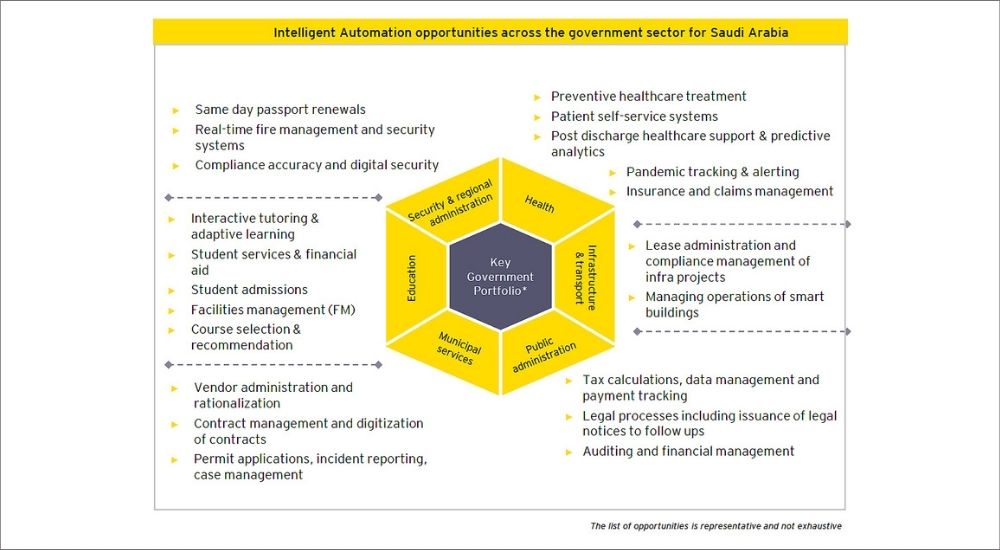

Key takeaways
- The impact of Covid-19 on the world economy has been severe with the World Bank terming it the worst recession since World War II.
- Saudi Arabia needs to accelerate its transformation journey, through a digital-first mindset realised through investments in new-age digital technologies.
- Saudi Arabia has based Vision 2030 goals on three pillars of competitive advantage.
- Saudi Arabia’s visionary reform manifested in 2030 goals has helped the kingdom add $150 billion to its GDP.
- As per global think tanks, the country has potential to double GDP by 2030 while reducing dependency on oil and gas.
- Intelligent Automation, combination of AI and Robotic Process Automation is a key lever in technology led productivity enhancement.
- Intelligent Automation can act as game changer for Saudi Arabia in its quest to attain goals of Vision 2030.
- A 30% incremental realisation in automation potential can boost Saudi Arabia’s economy by adding $293 billion to its nominal GDP by 2030.
All graphics and content, excerpted and edited from the report: Saudi Arabia, Showing the way to the world, Analysing the impact of automation on Saudi Arabia’s economy, by Ernst & Young and Automation Anywhere.





